 "What is Physics Good For?"
"What is Physics Good For?"
Extra credit is available at the end of this page. Please respond before 9 AM, Monday, September 11th, 2000.

Hurricanes
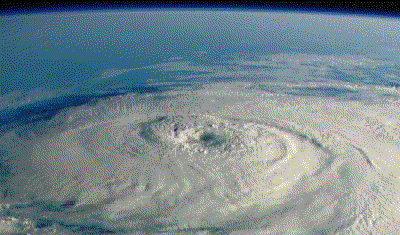
Physics is good for understanding natural phenomena.
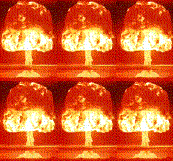 Hurricanes are among the most powerful of all natural phenomena, and by far the most powerful storms. At its peak, a severe storm may have a total power near to 1015 Watts: about 3,000 times the total electrical power generated in the world. This is equivalent to exploding 500,000
atomic bombs
per day (the little ones that were used at the end of WWII).
Hurricanes are among the most powerful of all natural phenomena, and by far the most powerful storms. At its peak, a severe storm may have a total power near to 1015 Watts: about 3,000 times the total electrical power generated in the world. This is equivalent to exploding 500,000
atomic bombs
per day (the little ones that were used at the end of WWII).
Where does this staggering quantity of power come from? Primarily, it comes the the condensation of water. You may recall that the latent heat of vaporization of water is 2.256 MJ/kg. That is, it takes 2.256 million Joules of energy to boil one kilogram of water. Of course, the reverse is also true. When one kilogram of water condenses, 2.256 million joules of energy become available.
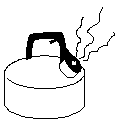
The process of hurricane formation is not completely understood, however, a rough outline exists. The necessary ingredients are
- A large area of warm ocean water (preferably at least 27 C).
- Latitude of at least 5 degrees (North or South)
- Vertical instability (low pressure at sea level is a good choice).
- Minimal vertical wind shear (no jet steams please!).
Of these conditions, the first provides the energy, the rest allow the storm to get organized into a self sustaining pattern that concentrates the energy.
First, air rushes in to fill the low pressure region (item 4 above). As the air moves in, moisture in the air condenses this releases energy, which in turn warms the air reducing its density. This warm air rises, pulling more air in from around the outside.
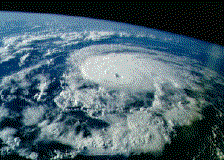 All of this air rushing in towards the center is subject to a phenomenon called the "Coriolis Force." This is much like the "centripetal force" in that it is not a "real" force like gravity or electrostatic force rather, it is an "apparent force" the occurs due to the motion of the Earth.
Imagine this, if a mass of air in the Northern hemisphere heads South towards a low pressure region, it is moving away form the Earth's axis. However, angular momentum must be conserved so if the distance from the axis increases, angular velocity must decrease. Thus, the mass of air must get a westward velocity. Similarly, air coming towards the center of the newly forming storm from the South acquires an eastward velocity. Overall, the storm picks up a counterclockwise rotation. It is this process that requires moderate latitude, the Coriolis force is zero at the equator, and is insufficient to organize the storm below about 5 degrees.
All of this air rushing in towards the center is subject to a phenomenon called the "Coriolis Force." This is much like the "centripetal force" in that it is not a "real" force like gravity or electrostatic force rather, it is an "apparent force" the occurs due to the motion of the Earth.
Imagine this, if a mass of air in the Northern hemisphere heads South towards a low pressure region, it is moving away form the Earth's axis. However, angular momentum must be conserved so if the distance from the axis increases, angular velocity must decrease. Thus, the mass of air must get a westward velocity. Similarly, air coming towards the center of the newly forming storm from the South acquires an eastward velocity. Overall, the storm picks up a counterclockwise rotation. It is this process that requires moderate latitude, the Coriolis force is zero at the equator, and is insufficient to organize the storm below about 5 degrees.
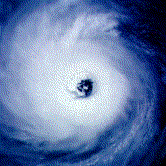
So, we now have a great deal of wind rushing in towards a center and rotating counterclockwise. If there is a great deal of wind shear (difference in wind speed vs. altitude) the storm can be broken up before it really gets going. However, if the rising column of air in the center can operate, then the storm really gets going. Up at high altitude cool air is pumped outwards away from the center of the storm, this allows more hot, moist air to be sucked in towards the center at sea level, The moisture in this air is condensed heating the air further and driving the whole process faster. Eventually, the center becomes the familiar "eye" of the hurricane.
The hurricane can continue for many days over so long as it remains over open, warm water. Over land, the lack of moisture and the increased friction will destroy it rapidly.
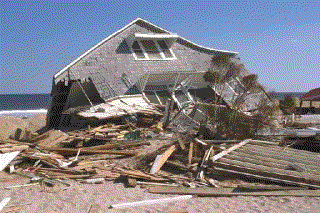 However, the hurricane can destroy a great deal on the land as well.
However, the hurricane can destroy a great deal on the land as well.
You can get a lot more information about this subject on the internet. Here are a few search engines
1. Alta Vista
2. Google
3. Northern Light
4. Ask Jeeves
5. Infoseek
And here are a few good links to get you started.
1.
 2.
2.
 3.
3.
 4.
4.
 5.
5.
Research Questions (1 point extra credit each!)
- Who was Beaufort?
- What is the difference between a hurricane, a typhoon and a cyclone.
- Besides wind, what is the greatest source of damage associated with hurricanes?
- (3 points) Use the data given above to calculate the number of kilowatt hours in an atomic bomb blast.
This site is made possible by funding from the National Science Foundation (DUE-9981111).
©2001 A. Gavrin and G. Novak, all rights reserved.
|



 "What is Physics Good For?"
"What is Physics Good For?"

 Hurricanes are among the most powerful of all natural phenomena, and by far the most powerful storms. At its peak, a severe storm may have a total power near to 1015 Watts: about 3,000 times the total electrical power generated in the world. This is equivalent to exploding 500,000
Hurricanes are among the most powerful of all natural phenomena, and by far the most powerful storms. At its peak, a severe storm may have a total power near to 1015 Watts: about 3,000 times the total electrical power generated in the world. This is equivalent to exploding 500,000

 All of this air rushing in towards the center is subject to a phenomenon called the "Coriolis Force." This is much like the "centripetal force" in that it is not a "real" force like gravity or electrostatic force rather, it is an "apparent force" the occurs due to the motion of the Earth.
Imagine this, if a mass of air in the Northern hemisphere heads South towards a low pressure region, it is moving away form the Earth's axis. However, angular momentum must be conserved so if the distance from the axis increases, angular velocity must decrease. Thus, the mass of air must get a westward velocity. Similarly, air coming towards the center of the newly forming storm from the South acquires an eastward velocity. Overall, the storm picks up a counterclockwise rotation. It is this process that requires moderate latitude, the Coriolis force is zero at the equator, and is insufficient to organize the storm below about 5 degrees.
All of this air rushing in towards the center is subject to a phenomenon called the "Coriolis Force." This is much like the "centripetal force" in that it is not a "real" force like gravity or electrostatic force rather, it is an "apparent force" the occurs due to the motion of the Earth.
Imagine this, if a mass of air in the Northern hemisphere heads South towards a low pressure region, it is moving away form the Earth's axis. However, angular momentum must be conserved so if the distance from the axis increases, angular velocity must decrease. Thus, the mass of air must get a westward velocity. Similarly, air coming towards the center of the newly forming storm from the South acquires an eastward velocity. Overall, the storm picks up a counterclockwise rotation. It is this process that requires moderate latitude, the Coriolis force is zero at the equator, and is insufficient to organize the storm below about 5 degrees.

 However, the hurricane can destroy a great deal on the land as well.
However, the hurricane can destroy a great deal on the land as well.
